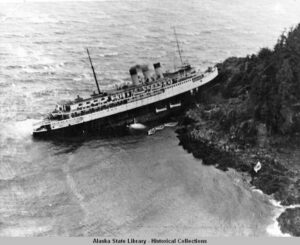- 1952

Aerial view of PRINCESS KATHLEEN wreck, 9-7-1952. Alaska State Library, John Romeo Photo Collection, Lu-ek’s Photo Shop photo, P342-113.
The Canadian Pacific Railroad cruise ship Princess Kathleen ran aground September 7 and sunk on Lena Point. All aboard made it to shore safely and were transported to Juneau for further care. Failure of the officer in command to issue a timely course correction to the helmsman resulted in the vessel ramming up onto the rocks at 9 knots. The vessel sank about ten hours after its collision.
The city of Juneau created a new public works department the end of November that now included operation of the water utilities system after voters approved acquisition of two private systems on August 5. Work proceeded to improve the system and planning moved forward to develop an “outer drive” connecting the downtown area to the bridge and western section of town. Urban renewal planning moved forward with federal grant assistance to identify project areas and scope of work.
Harborview Elementary School opened in September near Harris Harbor, responding to demographic population shift. Housing needs were partly addressed with the opening of Cedar Park low-rent public housing in July in west Juneau and plans were presented in November for construction of 40 duplex units in Douglas in anticipation of an influx of workers for new forest industry plants in the area.
show more
St. Ann’s Hospital initiated an ambitious funding drive in April to expand the hospital with a new four-story 36-bed wing to address under-capacity concerns and need to modernize the facility. Home postal delivery was initiated August 16 in the Juneau city limits. A “war on rats” was also initiated in November to address a less-welcomed problem. Heavy fall rains again produced flooding and landslide damage.
On the bright side, two new local community events were welcomed for youth activities – the Douglas Lions Club Halloween “Ghost Walk” for a carnival-like indoor “trick or treating” evening and a February winter carnival in Juneau, with various activities lasting several days. Radio station KJNO signed onto the air October 1.
Increased utilization of the region’s timber and fisheries resources was promoted for local economic development. The local sawmill, rebuilt after a disastrous 1949 fire, filled a large order for the Army in October and overall had the best year in its operation. A local corporation advanced plans to build a plywood plant next to the waterfront location of the sawmill, beginning operations the next season. Outside interests seriously looked at the Juneau area to build a pulp or newsprint plant, with strong support from the city and regional U.S. Forest Service agency. A new box factory began production in May in west Juneau, partly to provide containers for the local cold storage fisheries operation. New shrimp grounds were located in Taku Inlet and several processors started up for a winter season operation beginning in January. The Douglas crab cannery was heavily damaged in a January storm, however, but the city was able to provide an alternative location for continued crab and shrimp processing.
Waterfront workers were reminded by the U.S. Coast Guard June 20 that they should have security identification cards (based on a 1950 presidential executive order regarding national port security). Two maritime shipping strikes in the spring and fall, however, continued to underscore Juneau’s and Alaska’s vulnerability to supply delays, affecting most local services.
Improved transportation connections were promoted, including planning for a connection to the Alaska Highway system via a road up the Taku River valley, and expansion to a region-wide ferry system.
show less
